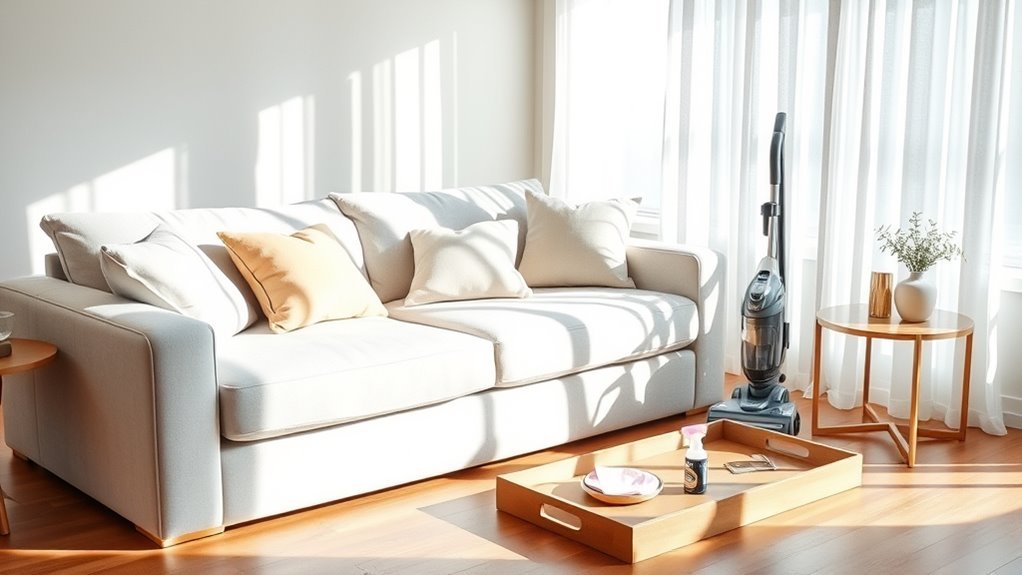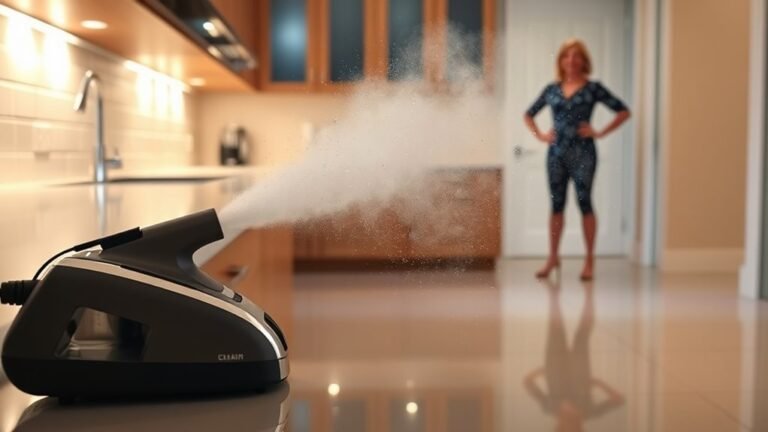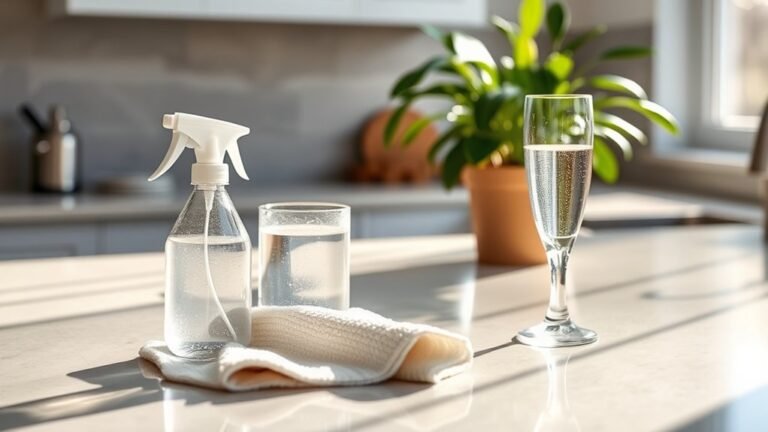Spring Cleaning Guide for Couch
For a fresh spring clean, first identify your couch’s fabric to choose safe cleaning methods. Gather soft brushes, microfiber cloths, and gentle cleaners. Remove cushions and vacuum every nook to clear dirt and crumbs. Treat stains carefully with solutions matched to the stain type, then deodorize with natural sprays. Let cushions dry in sunlight and fluff them up. Keep up with weekly vacuuming and quick spot cleans to maintain freshness. You can explore more ways to protect and prolong your couch’s life.
Assessing Your Couch Material

Before you plunge into cleaning, you need to know what your couch is made of. Understanding the fabric types and couch textures helps you tailor your approach, giving you the freedom to clean without worry. Different fabrics—like cotton, leather, microfiber, or velvet—each react uniquely to cleaning methods. Some may tolerate water-based cleaners, while others demand special care. Couch textures also matter; smooth leathers need gentle wiping, while textured weaves might trap dirt and require deeper attention. By identifying your couch’s material, you avoid damaging it and preserve its look and feel. So take a moment to check the label or test a hidden spot. Knowing this upfront lets you confidently freshen your couch this spring, freeing you from guessing and potential mishaps.
Gathering Essential Cleaning Supplies
To get your couch sparkling clean, you’ll need a few key supplies that match your couch’s material. Start by gathering effective cleaning tools like a soft-bristle brush for delicate fabrics or a sturdy scrubber for tougher surfaces. Don’t forget microfiber cloths—they’re great for wiping down without damaging fibers. Choose a vacuum with upholstery attachments to reach tight spots later on. Organizing supplies are just as important; having a small bin or basket to keep your sprays, brushes, and cloths handy will save you time and keep your space clutter-free. Grab a gentle, fabric-appropriate cleaner or a mild soap solution if you prefer natural options. With the right cleaning tools and organizing supplies at your fingertips, you’re all set to refresh your couch and enjoy a freer, cleaner living space.
Removing Cushions and Vacuuming Thoroughly

Anyone tackling couch cleaning should start by removing the cushions to access hidden dirt and debris. This simple step lets you dive deep into cushion care, ensuring every corner is fresh and free from dust. Once cushions are out, use precise vacuum techniques—like using upholstery attachments and low suction settings—to avoid damaging fabric while lifting stubborn particles. Don’t forget to vacuum the couch frame and crevices where crumbs and pet hair hide. Taking the time for a thorough vacuum helps maintain your couch’s comfort and appearance, giving you the freedom to relax without worry. With cushions off and vacuum in hand, you’re well on your way to a cleaner, more inviting living space that reflects your fresh start.
Treating Stains With Appropriate Solutions
Three key steps will help you treat stains effectively on your couch. First, identify the stain types—whether it’s oil, ink, food, or pet-related—so you can choose the right cleaning solutions. Next, always test your chosen solution on a hidden spot to avoid damage or discoloration. Finally, apply the cleaning solution gently; blot the stain instead of rubbing to prevent spreading. For oil-based stains, use a mild detergent mixed with water, while ink might need rubbing alcohol. Food stains often respond well to vinegar and water blends, and pet stains may require enzymatic cleaners to break down odors. By matching stain types with proper cleaning solutions, you’ll keep your couch fresh without restricting your freedom to enjoy it fully.
Cleaning Fabric Couch Upholstery

When cleaning your fabric couch upholstery, knowing the right stain removal techniques is key to keeping it looking fresh. You’ll also want to follow some simple fabric protection tips to prevent future damage. Let’s explore how to tackle stains effectively while preserving your couch’s material.
Stain Removal Techniques
Dealing with stains on your fabric couch can feel overwhelming, but having the right techniques makes the process much easier. First, identify the stain types—oil, ink, or food—and choose your cleaner accordingly. Always test on a hidden spot to guarantee color matching and avoid damage. Blot stains gently; never rub. Here’s a quick guide for common stains:
| Stain Type | Removal Method |
|---|---|
| Oil | Sprinkle baking soda, then vacuum |
| Ink | Dab with rubbing alcohol |
| Food | Use mild detergent with water |
| Wine | Blot with white vinegar solution |
Fabric Protection Tips
Although regular cleaning removes dirt and stains, protecting your fabric couch helps keep it looking fresh longer. Taking proactive steps in fabric care lets you enjoy your couch without worrying about permanent damage. Focus on stain prevention and maintaining the fabric’s integrity by adopting simple habits.
- Apply a fabric protector spray to repel spills and stains.
- Rotate cushions regularly to guarantee even wear.
- Keep pets off the couch or use washable covers.
- Clean spills immediately with a damp cloth.
- Avoid direct sunlight to prevent fading.
Deep Cleaning Leather Couches
Since leather requires special care, deep cleaning your leather couch means using the right products and techniques to avoid damage. Start by vacuuming crevices to remove dust and debris. Next, use a leather-specific cleaner—never harsh detergents—to gently lift dirt without stripping natural oils. Wipe with a soft, damp cloth and let it air dry. Conditioning leather afterward is essential to maintain its suppleness and prevent cracking. Apply a quality leather conditioner evenly, allowing it to soak in fully. This step not only nourishes the material but also restores that soft, flexible feel you love. By following these leather care basics, you’ll keep your couch looking fresh and free, letting you enjoy its comfort without worry or restriction.
Deodorizing Your Couch Naturally
When your couch starts to hold onto unwanted smells, you’ll want a natural solution that’s both effective and safe for your home. Baking soda is your best friend here—it absorbs odors without harsh chemicals. You can boost its power by adding a few drops of your favorite essential oils for a fresh, personalized scent. Here’s how to deodorize your couch naturally:
For a natural, effective couch deodorizer, sprinkle baking soda with essential oils to refresh your space safely.
- Sprinkle baking soda evenly over cushions and fabric.
- Add 5-10 drops of essential oils like lavender or eucalyptus to the baking soda.
- Let it sit for at least 30 minutes to absorb odors.
- Vacuum thoroughly to remove all baking soda residue.
- Repeat as needed to maintain a fresh, inviting space.
This simple method keeps your couch smelling clean and free, letting you enjoy your living space fully.
Drying and Fluffing Cushions
Once your cushions are clean, you’ll want to dry them thoroughly to prevent mold and odors. Using effective drying tips like air circulation and sunlight can speed up the process. After drying, fluffing your cushions will help restore their shape and comfort.
Effective Cushion Drying Tips
Although drying cushions might seem straightforward, doing it properly is key to preventing mold and maintaining their shape. To master cushion drying and moisture control, you need to be intentional and patient. Here’s how you can guarantee your cushions dry effectively without damage:
- Remove cushion covers and dry them separately.
- Air-dry cushions in a well-ventilated, sunny spot to speed up moisture evaporation.
- Avoid direct heat sources that can warp or shrink fabrics.
- Flip cushions regularly to let both sides dry evenly.
- Use a fan indoors if outdoor drying isn’t an option.
Techniques for Fluffing Cushions
Three simple techniques can instantly restore your cushions’ plumpness and comfort after drying. First, give each cushion a good shake to break up compacted filling—this simple act revives the loft and guarantees even distribution. Next, gently beat the cushions with your hands or a soft brush; this cushion fluffing method loosens fibers without damaging them. Finally, place cushions in the sun for a short while; sunlight naturally refreshes and helps eliminate trapped moisture. Incorporating these techniques into your regular cushion maintenance routine lets you enjoy a cozy couch that feels brand new. By committing to these easy steps, you free yourself from sagging, uncomfortable cushions and keep your space inviting and vibrant year-round.
Maintaining Your Couch Between Cleanings
To keep your couch looking fresh between deep cleanings, you’ll want to adopt a few simple habits that prevent dirt and stains from settling in. Regular maintenance keeps your couch inviting and extends its life without tying you down to constant scrubbing. Use these practical tips to stay on top of your couch care:
Simple habits prevent dirt buildup and keep your couch fresh between deep cleanings.
- Apply couch vacuuming tips weekly to remove dust and crumbs.
- Rotate cushions regularly to guarantee even wear and maintain shape.
- Spot clean spills immediately to avoid permanent stains.
- Use slipcovers or throws that can be washed easily.
- Keep pets off or groom them to reduce hair and dirt buildup.
Tips for Preventing Future Stains and Damage
To keep your couch looking fresh, you’ll want to apply protective fabric treatments that repel stains and spills. Developing regular maintenance habits, like quick spot cleaning and vacuuming, can also save you from bigger problems later. These simple steps make a big difference in preventing damage over time.
Protective Fabric Treatments
Several effective protective fabric treatments can help you keep your couch looking fresh and prevent future stains or damage. Exploring fabric protector options and mastering proper application techniques empower you to shield your couch without restricting your lifestyle. By choosing the right treatment, you maintain your freedom to enjoy your space worry-free.
Consider these key steps:
- Test fabric protectors on a hidden spot first.
- Apply evenly using a spray or brush for full coverage.
- Allow treatments to dry completely before use.
- Reapply treatments seasonally or after deep cleaning.
- Opt for eco-friendly products to keep your home safe.
With these simple measures, you’ll extend your couch’s life and keep it vibrant, letting you relax and live freely without constant worry about stains or wear.
Regular Maintenance Habits
While protective treatments give your couch a strong defense, regular maintenance habits are just as important for keeping it in top shape. You’ll want to stick to regular vacuuming to remove dust, crumbs, and pet hair that can wear down the fabric over time. Make it a habit to vacuum every week or two, depending on how much use your couch gets. Routine spot cleaning is equally essential; addressing spills and stains immediately prevents them from setting and becoming permanent. Keep a gentle upholstery cleaner or a simple mixture of water and mild detergent nearby for quick touch-ups. By combining these habits, you’ll protect your couch’s appearance and extend its life, all while enjoying the freedom of a clean, inviting space without stress or hassle.
Frequently Asked Questions
Can I Use a Steam Cleaner on All Couch Materials?
You shouldn’t use a steam cleaner on all couch materials without checking steam cleaner safety and material compatibility first. Some fabrics like velvet or silk can get damaged, while others like microfiber or cotton handle steam cleaning well. Always test a small hidden spot to avoid ruining your freedom to enjoy your couch. When in doubt, consult the manufacturer’s guidelines to keep your couch fresh without risking damage.
How Often Should I Replace Couch Cushions for Hygiene?
Did you know the average couch lifespan is about 7 to 15 years? You’ll want to replace couch cushions every 5 to 7 years to keep things fresh and hygienic. Cushion maintenance, like regular fluffing and spot cleaning, can extend their life, but over time, allergens and wear sneak in. Keeping cushions in good shape lets you enjoy your freedom to relax without worrying about hidden dirt or discomfort.
Are Professional Couch Cleaning Services Worth the Cost?
When deciding if professional couch cleaning services are worth the cost, you should weigh cost benefits carefully. Professionals offer deep cleaning that’s tough to match with DIY methods, saving you time and hassle. Comparing services reveals some provide eco-friendly options or quick drying, adding value. If you want freedom from scrubbing and guaranteed results, paying for expert service can be a smart investment that keeps your couch fresh longer.
What Are Eco-Friendly Alternatives to Commercial Couch Cleaners?
Imagine your couch as a peaceful meadow, free from harsh chemicals. You can embrace natural cleaning by mixing vinegar, baking soda, and water to create homemade solutions that gently lift dirt and odors. These eco-friendly alternatives let you clean with the freedom of nature, avoiding toxic fumes and protecting both your home and the planet. You’ll feel empowered knowing your space’s freshness comes from simple, safe ingredients you can trust.
How Do I Remove Pet Hair From My Couch Effectively?
If you’re tired of stubborn pet hair, try these removal techniques to reclaim your freedom from fuzz. Use a rubber glove or damp sponge to gently rub the couch surface; the hair will clump together for easy pickup. A lint roller or sticky tape works wonders too. For a deeper clean, vacuum with a pet hair attachment. These simple tricks help you enjoy a hair-free, comfy space without hassle.






